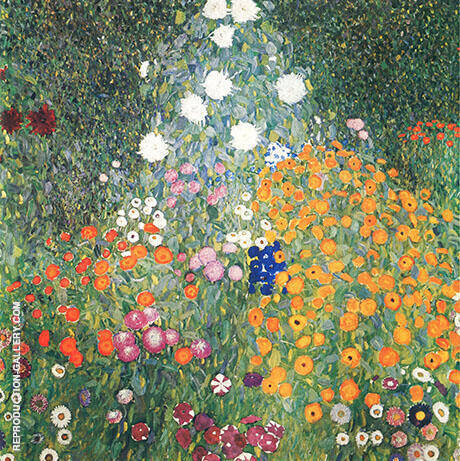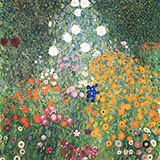Flower Garden 1907 By Gustav Klimt
Gustav Klimt Flower Garden (1907) is a riot of color and joyful expression. It is a fascinating work as a painting combining byzantine, impressionist, and post-impressionist inspirations. But what’s the story behind this stunning floral scene? Who painted The Flower Garden?Austrian artist, Gustav Klimt painted Flower Garden in 1907. He first exhibited the work at the Vienna “Kunstschau” exhibition in 1908. He produced many famous allegorical paintings and society portraits. Nonetheless, he also adored landscape painting and from the 1890s onwards, his paintings increasingly focused on the natural world. Indeed, toward the end of his career. Landscapes accounted for almost a quarter of Gustav Klimt’s paintings. The bright colors of Flower Garden create a positive and energetic composition. Beautiful white hydrangeas appear near the top of the painting. Pink and red shades dominate the left-hand side, while oranges take over the right. What inspired Klimt's flower paintings?Art by Gustav Klimt shifted toward landscape painting after seeing a major Van Gogh Exhibition in 1906. After visiting the Galerie Miethke in Vienna, Klimt adored Vincent van Gogh’s colorful post-impressionist style. He particularly admired Van Gogh’s use of pure color directly on the canvas. In addition, he appreciated Van Gogh’s experiments with flattened perspectives and close-up composition. As a result, The Flower Garden adopts many of these techniques and ideas. It also references Klimt’s interest in impressionist styles with relatively quick and free brushstrokes. It incorporates natural scenery and greenery, like many other impressionist artists. During this period, he also painted in the impressionist style “en plein air” (outside). What other Garden Paintings did the artist produce?Similar “garden” works include Farm Garden with Crucifix (1911) and Farm Garden with Sunflower (1913). Despite the similarity of these paintings, there is a seven year gap between the two paintings. Nevertheless, they demonstrate the artist's enduring fascination with the garden theme. Indeed, all three paintings represent a close-up view of simple flowers and foliage. Despite the novelty of the original Flower Garden, it developed many of Klimt’s favorite themes. For example, he adored byzantine stylings inspired by mosaics in Ravenna. In addition, his artwork includes the frequent use of bronze and gold, which transformed into yellows and oranges in Flower Garden. Chief among these byzantine inspirations was Klimt’s love of ornamental patterning and design. Illustrating this, Klimt The Kiss (1907) also displays floral backdrops and intensely decorative details. The Kiss also features a close-up perspective with no horizon line. The blooms gently blend and merge into the green background in the Flower Garden. The lack of defined space maintains the 2D mosaic feel of the painting. What do Gustav Klimt's flowers reveal?Gustav Klimt’s Flower Garden painting uses a pyramid structure, which despite the lack of a horizon, provides the form of the composition. It simply depicts a small flower garden that takes up the entire canvas. Like many other Gustav Klimt landscapes, it also skillfully uses complementary colors. Reds and green dominate the color palette. However, the occasional blue, purple, and white hints create additional exciting elements. These dabs of surprising tones encourage the viewer’s gaze to move around the whole scene. The artwork shows an array of flowers and foliage. While scholars can’t identify all the flowers, they could include daisies, pansies, nasturtiums, alliums, and poppies. How much is an original Klimt worth?Gustav Klimt Flower Garden sold for over $59 million in 2017. Auctioned by Sotheby’s in London, the painting set a record price for Gustav Klimt's landscape paintings. Nonetheless, the overall record for Gustav Klimt's paintings emerged in 2006. His portrait of Adele Block-Bauer II sold for over $87 million at Christie’s Auction House, New York. Famous art reproductionsIf you love Klimt flowers, explore our extensive collection of oil painting reproductions. Discover the top 100 famous paintings from our extensive catalog of colorful wall art paintings. |
We offer a 100% money back guarantee or replacement service. If for any reason you are dissatisfied with your painting please contact us within 7 days of receipt, advising the reason you are unhappy and we will provide you with all the information you need for its return or replacement.
We ship free to anywhere in the world via FedEx or DHL expedited service with online tracking.
Your painting will be shipped rolled in strong plastic tubing, ready for stretching and/or framing locally. This is the conventional method of transporting hand-painted oil on canvas. Learn more about how your painting is shipped.
We are able to offer a framing service intercontinental U.S. Please contact us if you would like a quotation. Alternatively, should you prefer, we can recommend a framer in your area.
Notes About Your Painting
Please note that replica oil paintings are finished with an additional 10cm (4") of extra canvas on all sides, allowing ample surplus canvas for stretching and framing.
Recently Viewed:
Cannot Find What You Are Looking For?
Reproduction Gallery Information
Customer Service
(Send Us A Message)
Tel: (503) 937 2010
Fax: (503) 937 2011







